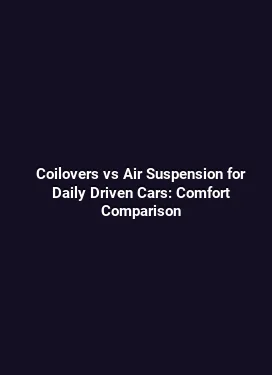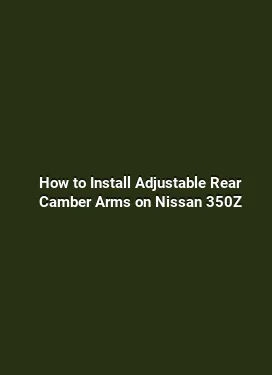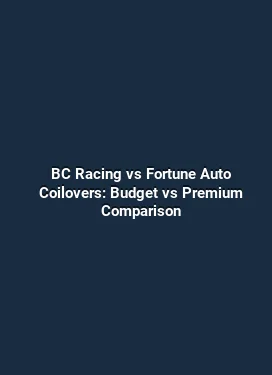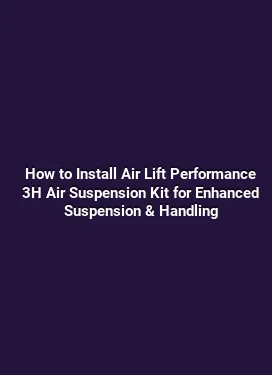Best Bushings Upgrade for Improved Handling Response: Complete Kit
Suspension and handling performance hinge on a well-chosen set of bushings. The upgrade path that's right for your vehicle depends on driving style, road conditions, and the balance you seek between comfort and cornering precision. This comprehensive guide explores the anatomy of a complete bushing kit, why different materials matter, how to choose the right combination for your car, and practical installation and maintenance steps that deliver tangible on-road gains. By focusing on real-world performance metrics such as steering feel, body control during mid-corner transitions, and reactiveness to abrupt surface imperfections, readers will gain actionable insights to optimize handling without compromising ride quality.
What a Complete Bushing Kit Typically Includes and Why Each Component Matters

A complete kit generally bundles bushings for control arms, subframe mounts, sway bar linkages, steering rack bushings, and shock absorbers’ end-links or control arm bushings. Each component serves a distinct dynamic role. Control arm bushings influence wheel alignment under load, affecting camber and toe shifts during compression and rebound. Subframe mounts help isolate engine torque and chassis movement, which in turn reduces unwanted steering inputs. Sway bar bushings control roll stiffness and body lean, while steering rack bushings affect steering response and column feedback. Understanding these roles lays the foundation for a balanced upgrade rather than a collection of isolated parts.
Material choice is the most influential variable in how a kit behaves on the road. The most common options include OEM rubber, polyurethane, and advanced composite billets or solid bushings. Each offers a unique blend of fade resistance, durability, and feedback. Rubber provides the most natural feel and vibration isolation but can degrade under aggressive driving. Polyurethane reduces deflection and can be tuned for precision, though it can transmit more harshness if not paired with compatible dampers. Advanced composites or spherical designs can deliver near-zero deflection in critical locations, offering the sharpest response at the cost of potentially harsher ride. A complete kit may also include additive lubricants or installation tools designed to ensure proper seating without damaging the control arms or subframes.
Choosing the Right Materials for Your Driving Style
For daily-driven street cars, a high-durometer polyurethane with strategic durometer variations (softer in some bushings, firmer in others) often provides a meaningful improvement in steering response while preserving ride comfort. In contrast, performance-oriented street/track cars benefit from advanced compounds that minimize slip and maximize load retention during high-G cornering. If a vehicle spends most of its life on imperfect pavement, selecting bushings with excellent isolation characteristics remains important to avoid amplified road noise and harshness. When mixed appropriately, these materials can create a harmonious, predictable feel rather than a jarring jump in stiffness across the chassis.
In performance applications, spherical or sleeved bushings reduce bind and allow more precise alignment of suspension geometry under dynamic loads. However, they can transmit more vibrations. The decision often comes down to whether the driver prioritizes immediate steering feedback or overall ride compliance. For off-road or rally-inspired builds, rugged poly bushings with higher shear modulus are favored for their resistance to abrasion and environmental exposure, ensuring consistent performance in variable conditions.
Understanding Damping and the Role of the Surrounding Components

Bushings do not operate in isolation. Their performance is tightly coupled with the damping characteristics of shock absorbers and springs, as well as the mounting hardware. A stiff bushing can only contribute to handling improvements if the dampers and springs can manage the energy transfer without excessive amplification of road irregularities. Conversely, a softer bushing paired with high-damping shocks can feel slow to respond, producing float or sluggish steering. The interplay between bushings and dampers defines the overall suspension tone—refined and precise or compliant and forgiving—so kit selection should consider the entire system rather than components in isolation.
Assessing Vehicle-Specific Requirements: Weight, Usage, and Chassis Geometry
Two vehicles with identical stock setups can respond very differently to a bushing upgrade due to differences in chassis stiffness, suspension geometry, and weight distribution. Heavier cars with aging suspension components often benefit from stiffer bushings that reduce deflection under load, but care must be taken to prevent NVH (noise, vibration, harshness) from overtaking ride quality. Lighter performance cars can tolerate or even thrive with slightly stiffer bushings because the chassis has less inertia and responds more readily to small changes in stiffness. A practical approach involves evaluating progressive stiffness concepts, using laboratory test data when available, and validating with on-road drives to ensure the upgrade aligns with the intended driving profile.
Additionally, alignment sensitivity rises after bushing upgrades. Changes in camber and toe during suspension travel may occur if bushings settle or deform under load. A thorough wheel alignment after installation helps lock in the intended geometry, maximizing the gains in handling and steering precision. It’s common to see small, progressive changes in toe or camber readings during the first few hundred miles as bushings bed in; a follow-up alignment check can catch small drifts early before tire wear becomes noticeable.
Step-by-Step Installation Guide for a Typical Complete Kit
While installation specifics vary by vehicle, a structured approach reduces risk and improves outcomes. Start with a review of the factory service manual to identify torque specs and safe disassembly points. Gather the necessary tools, including a jack, stands, a torque wrench, and any specialized bushings tools recommended by the kit manufacturer. Prior to disassembly, inspect surrounding components for wear, including control arm bushings, ball joints, and subframe mounts, to determine if related parts should be replaced simultaneously to avoid premature wear or mismatched flex characteristics.
1) Vehicle elevation and safety: Secure the car on level ground, apply wheel chocks, and raise to access height. Remove wheels to expose the suspension components and reduce risk during disassembly. 2) Document old geometry: Take reference measurements of camber, toe, and ride height to guide reassembly and alignment after install. 3) Dismantle carefully: Remove old bushings, noting any spacers or sleeves that must be reused or replaced. Clean mounting holes and surfaces to ensure proper seating. 4) Install new bushings: Lubricate where required with the supplied grease and press bushings into the correct control arms or mounts, paying attention to orientation marks or dash codes. 5) Reassemble: Refit components in the reverse order, torque to factory specifications, and verify that no interference exists with nearby suspension parts. 6) Post-install checks: Ensure full steering lock is clear of contact and recheck all fasteners after a test drive to confirm stability and secure mounting.
Proper lubrication and seating are essential in the early miles. Some kits require a break-in period for the bushings to settle into their new deflection characteristics. During this period, avoid aggressive throttle or braking inputs in tight corners. A gradual increase in steering input while monitoring tire feedback helps the driver gauge the new steering response and chassis balance. If the kit includes adjustable bushings, small changes can be made in the first few sessions to dial in the desired response without drastically altering ride quality.
Alignment and Tire Interaction after Upgrade
Post-install alignment is not a mere formality; it’s a critical step that influences how the upgraded bushings translate into road behavior. With stiffer bushings, the suspension geometry can shift under load, affecting camber gain and toe-out. A fresh alignment ensures that the wheels are tracking correctly through the range of motion, which is essential for predictable handling and even tire wear. Tires themselves respond quickly to changes in suspension stiffness. A compound that matches the intended handling profile—grip, feedback, and sidewall compliance—complements the upgraded bushings and helps achieve the desired balance between rigidity and comfort.
Real-World Driving Scenarios: How Upgraded Bushings Change Handling Dynamics
In straight-line stability, upgraded bushings reduce unwanted movement in the subframe and control arms, resulting in cleaner wheel alignment under braking and acceleration loads. On winding back roads, the steering becomes more linear, with less wobble or vagueness at the limit. During mid-corner transitions, a well-muked kit helps reduce chassis creep and helps the car rotate more predictably, allowing the driver to place the nose with greater confidence. In high-speed sweepers, the reduced deflection translates into more consistent tire contact with the road surface, which translates into more precise turn-in characteristics and better feedback through the steering wheel.
Edge cases include road surface irregularities such as expansion joints or potholes. The right bushings absorb or transmit these inputs in a controlled fashion, maintaining a stable ride height and preventing sudden changes in toe that would destabilize the car. For track use, the ability to maintain consistent geometry through repetitive cornering loads becomes a differentiator between a vehicle that simply rides the bumps and one that stays planted and responsive through the corner apex.
Maintenance, Longevity, and Signs of Wear
Maintenance is about preventive checks and recognizing wear patterns early. Inspect bushings for signs of cracking, tearing, or extrusion, especially in high-stress locations such as lower control arms and front subframe mounts. Polyurethane and composite bushings can last several seasons in favorable conditions but may wear more quickly in harsh climates or with aggressive driving. If you notice excessive squeaks, unusual vibrations, or changes in steering feel, schedule a timely inspection to confirm whether bushings are the root cause or if other suspension components require attention.
Lubrication intervals, if applicable, depend on the kit manufacturer’s guidelines. For spherical bearings or zero-deflection designs, occasional lubrication may be necessary to preserve spin resistance and reduce friction. Periodic alignment checks are prudent after significant mileage or after hitting large road imperfections, as small shifts in geometry can accumulate into noticeable handling changes over time.
Common Misconceptions and Practical Truths
A frequent misconception is that stiffer is always better for handling. The truth is that handling is a balance between stiffness, damping, and chassis compliance. Overly stiff bushings can make the ride jarring and increase NVH, while too-soft bushings may dampen steering input and soften the car’s response. A well-designed kit considers the vehicle’s road manners and the driver’s goals. Another myth is that all polyurethane bushings must squeak; modern formulations reduce noise significantly when properly installed with the correct lubricants and correct fits in sleeves or sleeves-free designs.
Finally, do not underestimate the role of proper installation tooling. Misaligned bushings or improper press-fitting can create micro-movements that undermine the whole upgrade. Using the manufacturer-supplied tools or seeking professional installation helps ensure the kit delivers its intended performance gains without compromising reliability.
Trend Keywords and Semantically Related Concepts in Handling Upgrades
In the broader conversation around suspension upgrades, terms such as chassis stiffness, load transfer, understeer balance, oversteer mitigation, and contact patch optimization frequently appear. Related concepts include sustainable performance tuning, ride compliance versus precision, and the interplay between tire construction, tread pattern, and cornering grip. An informed shopper considers how these ideas integrate with the bushing kit to sustain consistent handling over a spectrum of road conditions and driving styles. The goal is to achieve a responsive yet stable platform that communicates reliably through the steering wheel and seat, enabling confident, controlled driving in everyday traffic and spirited sessions alike.






